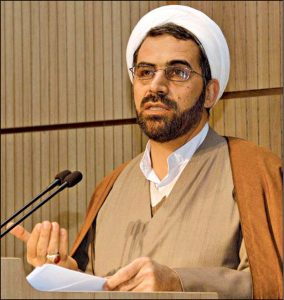Rasūl Jaʿfarīān, Ḥayāt-i Fikrī va Sīāsī-yi Imāmān-i Shīʿa [Intellectual and Political Life of Shiʿa Imāms], 6th ed., 1 vol., Qom: Anṣārīān Publication, 1423, 631 pp.
The Qurʾān presents the Prophet (s) as a good example for everyone, and according to the prophetic narrations in Shiʿa and Sunni sources, after him, one should adhere to the Qurʾān and the Ahl al-Bayt (a) in order not to go astray. Based on this, from the Shiʿa point of view, which is based on the Qurʾān and narrations, it is very important to know the Ahl al-Bayt (a) in order to set them as a role model, and therefore, many books about their life and conduct have been written by Shiʿa scholars throughout history. Ḥayāt-i Fikrī va Sīāsī-yi Imāmān-i Shīʿa [Intellectual and Political Life of Shiʿa Imāms] in Persian by Rasūl Jaʿfarīān explains the intellectual and political life of 12 Imāms (a).
 Born in 1343 (solar) in Isfahan, Iran, Rasūl Jaʿfarīān is a contemporary Shiʿa scholar who has special expertise in the history of Islam, Shiʿa history and history of Iran with an emphasis on the Safavid period, and has authored many books on these subjects, including Tārīkh-i Sīāsī-yi Islām, Taʾammulī dar Nihḍat-i ʿĀshūrā, Ṣafaviyya dar ʿArṣi-yi Dīn, and Aṭlas-i Shīʿa.
Born in 1343 (solar) in Isfahan, Iran, Rasūl Jaʿfarīān is a contemporary Shiʿa scholar who has special expertise in the history of Islam, Shiʿa history and history of Iran with an emphasis on the Safavid period, and has authored many books on these subjects, including Tārīkh-i Sīāsī-yi Islām, Taʾammulī dar Nihḍat-i ʿĀshūrā, Ṣafaviyya dar ʿArṣi-yi Dīn, and Aṭlas-i Shīʿa.
Ḥayāt-i Fikrī va Sīāsī-yi Imāmān-i Shīʿa begins with a detailed introduction by the author, and the contents are organized in twelve sections in such a way that each section is dedicated to one of the Imāms (a). In each section, the author first provides information about the birth and personality of the Imāms (a), and while pointing out the most prominent features of each of them, he has investigated the political and social conditions of their time. The purpose of writing this work is to deal with the political and intellectual aspects of the life of the Shiʿa Imāms (a), and therefore less attention is paid to personal issues. In the introduction, the author discusses Shiʿism and its relationship with historiography. The way of Shiite historiography at the beginning of the compilation era, Shiite works on the prophetic life in the first centuries, Persian works of the Shiʿa from the 7th to 10th century, and historiography in the Safavid era are among the topics that the author discusses in the introduction.
In the first part of the book, the life of Imām ʿAlī (a) has been examined. Rasūl Jaʿfarīān believes that the political and social life of the Imām (a) is a model of utopia, in the sense that his life is one of the best ways of life that has been experienced so far in human life. He considered asceticism to be one of the most important manifestations of Imām’s life, which prevailed his entire life.
The second part of Ḥayāt-i Fikrī va Sīāsī-yi Imāmān-i Shīʿa is dedicated to the personality of Imām Ḥasan (a). Imām Ḥasan (a) and the issue of Imamate, the religious and political characteristics of the people of Kufa, the Imām’s first actions against Muʿāwiya, Muʿāwiya’s request for peace from him, the reasons for accepting peace, the text of the peace agreement and the manner of his martyrdom are among the issues that have been discussed.
In the third part, the life of Imām Ḥusayn (a) is explained. Rasūl Jaʿfarīān seeks to answer the question, what was the reason of the martyrdom of Imām Ḥusayn (a)? Is this martyrdom political or spiritual? How Imām Ḥusayn (a) opposed Yazīd’s caliphate, the details of Muslim’s mission to Kufa, the Imām’s movement towards Iraq, the people of Kufa and Ibn Ziyād’s pressure on them, the Imām’s dealings with the Iraqi army, the awareness of martyrdom, and the political effects of the Karbalā event on Shiʿa are among the important topics that have been investigated in this section.
 In the fourth part of the book, aspects of the life of Imām Sajjād (a) have been analysed. The author has stated that the fourth Imām’s use of the tactic of prayer is his most important feature. He believes that when the society had deviated, the spirit of worldliness had overcome it and political, moral and social corruption had surrounded it, Imām Sajjād (a) was able to use prayer to express part of his beliefs. According to him, although apparently the main purpose of these supplications was to worship, people could get acquainted with the political concepts intended by Imām Sajjād (a) through these expressions.
In the fourth part of the book, aspects of the life of Imām Sajjād (a) have been analysed. The author has stated that the fourth Imām’s use of the tactic of prayer is his most important feature. He believes that when the society had deviated, the spirit of worldliness had overcome it and political, moral and social corruption had surrounded it, Imām Sajjād (a) was able to use prayer to express part of his beliefs. According to him, although apparently the main purpose of these supplications was to worship, people could get acquainted with the political concepts intended by Imām Sajjād (a) through these expressions.
The life of Imām Bāqir (a) has been analysed in the fifth section of Ḥayāt-i Fikrī va Sīāsī-yi Imāmān-i Shīʿa. Regarding the scientific status of Imām Bāqir (a), the writer believes that, in the opinion of many Sunni scholars, this noble Imām (a) had great fame during his lifetime and students from various Islamic countries took benefit from him. How Imām Bāqir (a) dealt with jurisprudential differences between Islamic sects, his struggle with Jews and fake narrations, his cultural heritage, and finally his relationship with political issues are some of the topics presented in this section.
In the sixth part, the moral and jurisprudential character of Imām Ṣādiq (a) has been taken into consideration. How Imām (a) dealt with the Exaggerators (Ghulāt), Shiʿa jurisprudence based on Sunni narrations, political pressure on Shiites and Imām Ṣādiq’s dealings with important political events such as the uprising of Zayd and Nafs Zakiyya are among the most important topics of this section.
In the same way, in the seventh to the twelfth sections, Rasūl Jaʿfarīān analyses the lives of the next six Shiite Imāms. In general, due to the author’s expertise in the history of Islam and Shiʿa, the intellectual and political life of 12 Imāms has been well analysed in this book, and the translation of this book into other languages is recommended.
